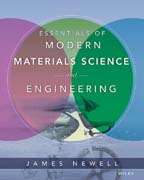
While other materials science books focus heavily on metals, Newell's Material Science and Engineering offers a unique approach that emphasizes modern materials such as polymers, ceramics, and composites. The book explores the key concepts and fundamentals that are needed to make informed decisions in the field. The importance of economics in decision-making and consideration of the entire life cycle of products are themes that are also integrated throughout the chapters. Engineers will be able to use this as a reference for the materials selection issues that they'll deal with throughout their careers. INDICE: 1. Introduction. Why Study Materials Science? 1.1 Overview of Materials Science. What Issues Impact Materials Selection and Design? 1.2 PropertyConsiderations for Specific Applications. 1.3 Impact of Bonding of Material Properties. 1.4 Changes of Properties over Time. 1.5 Impact of Economics on Decision Making. 1.6 Sustainability and Green Engineering. What Choices Are Available? 1.7 Classes of Materials. 2. Structure in Materials. How Are Atoms Arranged in Materials? 2.1 Introduction. 2.2 Level of Order. 2.3 Lattice Parametersand Atomic Packing Factors. 2.4 Density Estimations. 2.5 Crystallographic Planes. 2.6 Miller Indices. How Are Crystals Measured? 2.7 X-Ray Diffraction. 2.8Microscopy. How Do Crystals Form and Grow? 2.9 Nucleation and Grain Growth. What Kinds of Flaws Are Present in Crystals and What Do They Affect? 2.10 PointDefects. 2.11 Dislocations. 2.12 Slip. 2.13 Dislocation Climb. What New Developments Are Happening with Crystals and Crystal Structures? 2.14 Monocrystals and Nanocrystals. 3. Measurement of Mechanical Properties. How Do I Know How to Measure Properties? 3.1 ASTM Standards. What Properties Can Be Measured, andWhat Do They Tell Me? 3.2 Tensile Testing. 3.3 Compressive Testing. 3.4 Bend Testing. 3.5 Hardness Testing. 3.6 Creep Testing. 3.7 Impact Testing. Will I Get the Same Result Every Time I Run a Specific Test? 3.8 Error and Reproducibility in Measurement. Why Do Materials Fail Under Stress? 3.9 Fracture Mechanics. How Do Mechanical Properties Change Over Time? 3.10 Fatigue Testing. 3.11 Accelerated Aging Studies. 4. Metals. How Do You Work with Metals? 4.1 Forming Operations. What Advantages Do Alloys Offer? 4.2 Alloys and Phase Diagrams. 4.3 Carbon Steel. 4.4 Phase Transitions. 4.5 Age Hardening (Precipitation Hardening). 4.6 Copper and Its Alloys. 4.7 Aluminum and Its Alloys. What LimitationsDo Metals Have? 4.8 Corrosion. What Happens to Metals after Their Commercial Life? 4.9 Recycling of Metals. 5. Polymers What Are Polymers? 5.1 Polymer Terminology. 5.2 Types of Polymers. How Are Polymer Chains Formed? 5.3 Addition Polymerization. 5.4 Condensation Polymerization. 5.5 Importance of Molecular Weight Distributions. What Influences the Properties of Polymers? 5.6 Constitution. 5.7 Configuration. 5.8 Conformation. 5.9 Additives. How Are Polymers Processed into Commercial Products? 5.10 Polymer Processing. What Happens to Polymers When They Are Discarded? 5.11 Recycling of Polymers. 6. Ceramics and Carbon Materials. What Are Ceramic Materials? 6.1 Crystal Structures in Ceramics. What Are the Industrial Uses of Ceramics? 6.2 Abrasives. 6.3 Glasses 6.4 Cements.6.5 Refractories. 6.6 Structural Clay Products 6.7 Whitewares 6.8 Advanced Ceramics. What Happens to Ceramic Materials at the End of Their Useful Lives? 6.9 Recycling of Ceramic Materials. Is Graphite a Polymer or a Ceramic? 6.10 Graphite. Do Other Carbon Materials Offer Unusual Properties? 6.11 Diamond. 6.12 Carbon Fibers. 6.13 Fullerenes (Buckyballs) and Carbon Nanotubes. 7. Composites. What Are Composite Materials, and How Are They Made? 7.1 Classes of Composites. 7.2 Fiber-Reinforced Composites. 7.3 Particulate Composites. 7.4 Laminar Composites What Happens to Obsolete Composites? 7.5 Recycling of Composite Materials. 8. Electronic and Optical Materials. How Do Electrons Flow through Metals? 8.1 Conductivity in Metals. 8.2 Electrical Resistivity. What Happens WhenThere Are No Free Electrons? 8.3 Insulators. 8.4 Intrinsic Semiconduction. 8.5 Extrinsic Semiconduction. How Do Electronic Devices Operate? 8.6 Diodes. 8.7Transistors. 8.8 Integrated Circuits. 8.9 Dielectric Behavior and Capacitors.What Other Electrical Behaviors Do Some Materials Display? 8.10 Ferroelectricand Piezoelectric Materials. What Are Optical Properties, and Why Do They Matter? 8.11 Optical Properties. 8.12 Applications of Optical Materials. 9. Biomaterials and Biological Materials. What Types of Materials Interact with Biological Systems? 9.1 Biomaterials, Biological Materials, and Biocompatibility. What Biological Materials Provide Structural Support, and What Biomaterials Interact with or Replace Them? 9.2 Structural Biological Materials and Biomaterials. What Biomaterials Serve a Nonstructural Function in the Body? 9.3 Functional Biomaterials. What Ethical Issues Are Unique to Biomaterials? 9.4 Ethics andBiomaterials. Appendix A: Major Producers of Metals and Polymers. Appendix B:Properties of Major Metals and Alloys. Glossary. Index.
- ISBN: 978-0-471-75365-0
- Editorial: John Wiley & Sons
- Encuadernacion: Rústica
- Páginas: 332
- Fecha Publicación: 09/01/2009
- Nº Volúmenes: 1
- Idioma: Inglés
